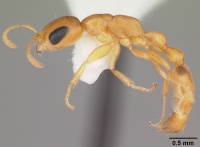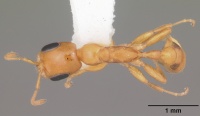Pseudomyrmex pallidus
| Pseudomyrmex pallidus | |
|---|---|

| |
| Scientific classification | |
| Kingdom: | Animalia |
| Phylum: | Arthropoda |
| Class: | Insecta |
| Order: | Hymenoptera |
| Family: | Formicidae |
| Subfamily: | Pseudomyrmecinae |
| Genus: | Pseudomyrmex |
| Species: | P. pallidus |
| Binomial name | |
| Pseudomyrmex pallidus (Smith, F., 1855) | |
A common and widespread species that opportunistically nests within a wide range of cavities, from dead stalks of herbaceous plants to dead twigs in trees.
| At a Glance | • Polygynous |
Identification
Ward (1985) - This is the most common and widespread member of the pallidus group. P. pallidus shows considerable geographical variation in size, sculpture, and body proportions (note wide ranges of some metrics). However the workers are consistently orange-brown in color, with contiguous frontal carinae (MFC < 0.025), moderately long eyes (REL2 > 0.52), and (at least weakly) coriarious-punctulate sculpture on the vertex. No other Nearctic species possesses this combination of characters. Specific differences between P. pallidus and other orange Pseudomyrmex (Pseudomyrmex apache, Pseudomyrmex leptosus, Pseudomyrmex seminole and Pseudomyrmex simplex) are discussed under those species.
Keys including this Species
Distribution
Latitudinal Distribution Pattern
Latitudinal Range: 36.62342° to -19.6°.
| North Temperate |
North Subtropical |
Tropical | South Subtropical |
South Temperate |
- Source: AntMaps
Distribution based on Regional Taxon Lists
Nearctic Region: United States (type locality).
Neotropical Region: Argentina, Belize, Bolivia, Brazil, Colombia, Costa Rica, Cuba, Greater Antilles, Guatemala, Honduras, Mexico, Paraguay, Trinidad and Tobago, Uruguay.
Distribution based on AntMaps
Distribution based on AntWeb specimens
Check data from AntWeb
Countries Occupied
| Number of countries occupied by this species based on AntWiki Regional Taxon Lists. In general, fewer countries occupied indicates a narrower range, while more countries indicates a more widespread species. |

|
Biology
Ward (1985) - P. pallidus exhibits diversity in its choice of nesting sites. While it shows a preference for dead stalks or culms of herbaceous plants, it will also nest in dead twigs or branches of shrubs and trees in some localities.
By state, the Nearctic nest-site records are from the following plants (based on personal observations or on museum material which I have examined):
Florida: Ambrosia artemisiifolia, Andropogon, Bidens, Cladium jamaicense, Uniola paniculata.
Georgia: Callicarba.
Texas: Baccharis, Heterotheca subaxillaris, Iva ciliata, Melia azedarach, Prunus, Ptelea trifoliata, Uniola paniculata.
Arizona: Gossypium thurberi, Quercus emoryi, Q. oblongifolia.
California: Acacia greggii, Hyptis emoryi.
The number of functional queens in a colony varies widely. The majority of P. pallidus nests which I dissected from Texas and Florida were queenless or monogynous, but sometimes larger numbers of mated, dealate queens cohabited (up to a maximum of 22). Since P. pallidus colonies are often polydomous, the number of queens per colony may be higher.
P. pallidus alates have been collected in every month of the year, indicating that mating occurs in more than one season.
Koch et al. (2018) sampled this species in Caryocar barsiliense trees, in southeastern Brazil cerrado, as part of a study examining species interactions in ant-plants.
Atchison & Lucky (2022) found that this species, as expected, does not remove seeds.
This species is a host for the ant Pseudomyrmex seminole (a temporary parasite) (Ward, 1985).
Life History Traits
- Queen number: polygynous (Frumhoff & Ward, 1992)
Castes
Worker
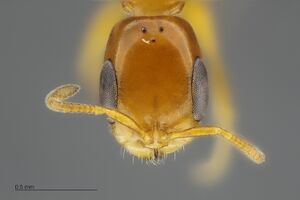   
| |
| Worker. . | Owned by Museum of Comparative Zoology. |
Images from AntWeb
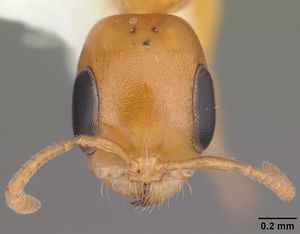 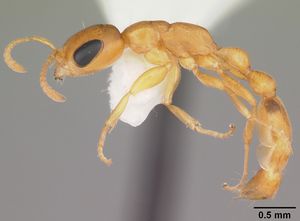  
| |
| Worker. Specimen code casent0103890. Photographer April Nobile, uploaded by California Academy of Sciences. | Owned by ABS, Lake Placid, FL, USA. |
   
| |
| Worker. Specimen code casent0005441. Photographer April Nobile, uploaded by California Academy of Sciences. | Owned by UCDC, Davis, CA, USA. |
Queen
Images from AntWeb
    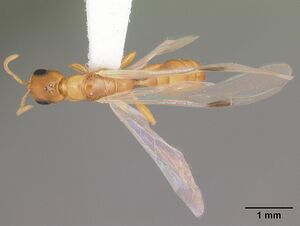 
| |
| Queen (alate/dealate). Specimen code casent0103866. Photographer April Nobile, uploaded by California Academy of Sciences. | Owned by ABS, Lake Placid, FL, USA. |
Male
Images from AntWeb
 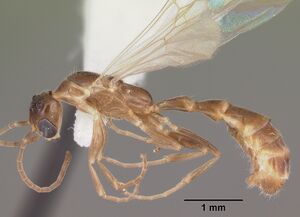 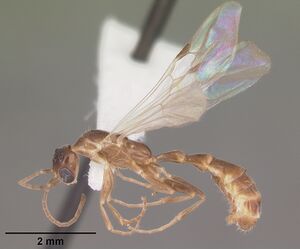  
| |
| Male (alate). Specimen code casent0104249. Photographer April Nobile, uploaded by California Academy of Sciences. | Owned by ABS, Lake Placid, FL, USA. |
Nomenclature
The following information is derived from Barry Bolton's Online Catalogue of the Ants of the World.
- pallidus. Pseudomyrma pallidus Smith, F. 1855c: 160 (w.) U.S.A. Wheeler, G.C. & Wheeler, J. 1956: 386 (l.); Petralia & Vinson, 1980: 381 (l.). Combination in Leptalea: Smith, M.R. 1951a: 788; in Pseudomyrmex: Wheeler, G.C. & Wheeler, J. 1956: 386. Subspecies of flavidulus: Enzmann, E.V. 1944: 66. Revived status as species: Smith, M.R. 1947f: 544; Creighton, 1950a: 80. See also: Blum & Callahan, 1963: 69; Ward, 1985b: 235.
Unless otherwise noted the text for the remainder of this section is reported from the publication that includes the original description.
Description
Worker
Ward (1985) - Measurements (n = 70): HL 0.78-1.06, HW 0.68-0.89, MFC 0.011-0.024, CI 0.77-0.91, OI 0.54-0.62, REL 0.45-0.54, REL2 0.53-0.65, OOI 0.78-2.08, VI 0.67-0.84, FCI 0.015-0.033, SI 0.41-0.49, SI2 0.68-0.85, FI 0.37-0.45, PDI 1.10-1.52, MPI 0.022-0.054, NI 0.54-0.67, PLI 0.47-0.62, PWI 0.38-0.52, PPWI 0.85-1.18.
Diagnosis. - Medium-sized species (for the pallidus group), with moderately broad head (HW 0.68-0.89, CI 0.77-0.91); anterior clypeal margin medially flat, laterally angulate: distance between frontal carinae less than basal width of scape; eyes moderately long. EL greater than scape length: occipital margin convex, flat or weakly concave, in full-face, dorsal view; lateral margins of pronotum rounded; metanotal groove present but shallow; basal face of propodeum longer than declivitous face, and more or less differentiated from it; petiole slender, with a distinct anterior peduncle and anteroventral tooth. Head subopaque to weakly shining; frons densely punctulate on a coriarious background; punctures less dense on the vertex which remains (at least weakly) coriarious; dorsum of mesosoma and petiole sublucid, coriarious-punctulate, becoming coriarious-imbricate laterally; postpetiole and gaster weakly shining, covered with numerous, very fine piligerous punctures. Erect pilosity sparse, lacking on mesonotum, propodeum, and mid and hind femora; one to several erect setae on dorsum of head, pronotum, petiole, postpetiole, and abdominal tergite IV. Fine, appressed pubescence present on most parts of body, forming a moderately dense mat on abdominal tergite IV, which partially obscures the sheen of the integument. Body orange-brown, with paler mandibles and appendages: a pair of anterolateral fuscous patches sometimes present on abdominal tergite IV.
Type Material
Ward (1985) - One syntype queen (dealate), one syntype worker, "U.S.” (The Natural History Museum) (Examined). Syntype worker here designated as LECTOTYPE.
References
- Atchison, R. A., Lucky, A. 2022. Diversity and resilience of seed-removing ant species in Longleaf Sandhill to frequent fire. Diversity 14, 1012 (doi:10.3390/d14121012).
- Baena, M.L., Escobar, F., Valenzuela, J.E. 2019. Diversity snapshot of green–gray space ants in two Mexican cities. International Journal of Tropical Insect Science 40, 239–250 (doi:10.1007/s42690-019-00073-y).
- Blum, M. S.; Callahan, P. S. 1963. The venom and poison glands of Pseudomyrmex pallidus (F. Smith). Psyche (Camb.) 70: 69-74. (page 69, see also)
- Creighton, W. S. 1950a. The ants of North America. Bulletin of the Museum of Comparative Zoology 104: 1-585 (page 80, Revived status as species)
- Davis, T. 2009. The ants of South Carolina (thesis, Clemson University).
- Del-Claro, K., Rodriguez-Morales, D., Calixto, E.S., Martins, A.S., Torezan-Silingardi, H.M. 2019. Ant pollination of Paepalanthus lundii (Eriocaulaceae) in Brazilian savanna. Annals of Botany 123, 1159–1165 (doi:10.1093/aob/mcz021).
- Deyrup, M.A., Carlin, N., Trager, J., Umphrey, G. 1988. A review of the ants of the Florida Keys. Florida Entomologist 71: 163-176.
- Enzmann, E. V. 1944. Systematic notes on the genus Pseudomyrma. Psyche (Camb.) 51: 59-103 (page 66, Variety of flavidulus)
- Hernández‐Flores, J., Flores‐Palacios, A., Vásquez‐Bolaños, M., Toledo‐Hernández, V.H., Sotelo‐Caro, O., Ramos‐Robles, M. 2020. Effect of forest disturbance on ant (Hymenoptera: Formicidae) diversity in a Mexican tropical dry forest canopy. Insect Conservation and Diversity (doi:10.1111/icad.12466).
- Ipser, R.M., Brinkman, M.A., Gardner, W.A., Peeler, H.B. 2004. A survey of ground-dwelling ants (Hymenoptera: Formicidae) in Georgia. Florida Entomologist 87: 253-260.
- Koch, E. B. A., W. Dattilo, F. Camarota, and H. L. Vasconcelos. 2018. From species to individuals: does the variation in ant-plant networks scale result in structural and functional changes? Population Ecology. 60:309-318. doi:10.1007/s10144-018-0634-5
- Mackay, W.P. & Mackay, E.E. 2002. The Ants of New Mexico: 400 pp. Edwin Mellen Press, Lewiston, N.Y.
- Petralia, R. S.; Vinson, S. B. 1980 [1979]. Comparative anatomy of the ventral region of ant larvae, and its relation to feeding behavior. Psyche (Camb.) 86: 375-394 (page 381, larva described)
- Smith, F. 1855c. Descriptions of some species of Brazilian ants belonging to the genera Pseudomyrma, Eciton and Myrmica (with observations on their economy by Mr. H. W. Bates). Trans. Entomol. Soc. Lond. (2) 3: 156-169 (page 160, worker described)
- Smith, M. R. 1947f. A generic and subgeneric synopsis of the United States ants, based on the workers. Am. Midl. Nat. 37: 521-647 (page 544, Revived status as species)
- Smith, M. R. 1951c. Family Formicidae. Pp. 778-875 in: Muesebeck, C. F., Krombein, K. V., Townes, H. K. (eds.) Hymenoptera of America north of Mexico. Synoptic catalogue. U. S. Dep. Agric. Agric. Monogr. 2:1-1420. (page 788, Combination in Leptalea)
- Varela-Hernández, F., Medel-Zosayas, B., Martínez-Luque, E.O., Jones, R.W., De la Mora, A. 2020. Biodiversity in central Mexico: Assessment of ants in a convergent region. Southwestern Entomologist 454: 673-686.
- Ward, P. S. 1985b. The Nearctic species of the genus Pseudomyrmex (Hymenoptera: Formicidae). Quaest. Entomol. 21: 209-246 (page 235, see also)
- Wheeler, G. C.; Wheeler, J. 1956. The ant larvae of the subfamily Pseudomyrmecinae (Hymenoptera: Formicidae). Ann. Entomol. Soc. Am. 49: 374-398 (page 386, Combination in Pseudomyrmex)
- Wheeler, G. C.; Wheeler, J. 1956. The ant larvae of the subfamily Pseudomyrmecinae (Hymenoptera: Formicidae). Ann. Entomol. Soc. Am. 49: 374-398 (page 386, larva described)
References based on Global Ant Biodiversity Informatics
- Addison D. S., I. Bartoszek, V. Booher, M. A. Deyrup, M. Schuman, J. Schmid, and K. Worley. 2016. Baseline surveys for ants (Hymenoptera: Formicidae) of the western Everglades, Collier County, Florida. Florida Entomologist 99(3): 389-394.
- Alayo D. P. 1974. Introduccion al estudio de los Himenopteros de Cuba. Superfamilia Formicoidea. Academia de Ciencias de Cuba. Instituto de Zoologia. Serie Biologica no.53: 58 pp. La Habana.
- Annotated Ant Species List Ordway-Swisher Biological Station. Downloaded at http://ordway-swisher.ufl.edu/species/os-hymenoptera.htm on 5th Oct 2010.
- Antoniazzi R., R. N. S. L. Garoo, W. Dattilo, S. P. Ribeiro, and F. S. Neves. 2019. Ant species richness and interactions in canopies of two distinct successional stages in a tropical dry forest. The Science of Nature 106: 20
- Badano, E.I., H.A. Regidor, H.A. Nunez, R. Acosta and E. Gianoli. 2005. Species richness and structure of ant communities in a dynamic archipelago: effects of island area and age. Journal of Biogeography
- Brandao, C.R.F. 1991. Adendos ao catalogo abreviado das formigas da regiao neotropical (Hymenoptera: Formicidae). Rev. Bras. Entomol. 35: 319-412.
- Bruch C. 1914. Catálogo sistemático de los formícidos argentinos. Revista del Museo de La Plata 19: 211-234.
- Calcaterra L. A., F. Cuezzo, S. M. Cabrera, and J. A. Briano. 2010. Ground ant diversity (Hymenoptera: Formicidae) in the Ibera nature reserve, the largest wetland of Argentina. Ann. Entomol. Soc. Am. 103(1): 71-83.
- Colby, D. and D. Prowell. 2006. Ants (Hymenoptera: Formicidae) in Wet Longleaf Pine Savannas in Louisiana. Florida Entomologist 89(2):266-269
- Coronado-Blanco J. M., D. A. Dubovikoff, E. Ruiz-Cancino, M. Vasquez-Bolanos, K. Y. Flores-Maldonado, and J. V. Horta-Vega. 2013. Formicidae (Hymenoptera) del estado de Tamaulipas, Mexico. CienciaUat 25(1): 12-17.
- Cover S. P., and R. A. Johnson. 20011. Checklist of Arizona Ants. Downloaded on January 7th at http://www.asu.edu/clas/sirgtools/AZants-2011%20updatev2.pdf
- Cuezzo, F. 1998. Formicidae. Chapter 42 in Morrone J.J., and S. Coscaron (dirs) Biodiversidad de artropodos argentinos: una perspectiva biotaxonomica Ediciones Sur, La Plata. Pages 452-462.
- Cupul-Magnana F. G. 2005. Registro de hormigas (Hymenoptera: Formicidae) en un remanente de dunas costeras de Puerto Vallarta, Jalisco, Mexico. Ciencia y Mar 29: 25-31.
- Dash S. T. and L. M. Hooper-Bui. 2008. Species diversity of ants (Hymenoptera: Formicidae) in Louisiana. Conservation Biology and Biodiversity. 101: 1056-1066
- Dattilo W. et al. 2019. MEXICO ANTS: incidence and abundance along the Nearctic-Neotropical interface. Ecology https://doi.org/10.1002/ecy.2944
- Dean D. A., and S. R. Dean. 2018. A survey of the ant fauna and seasonal alate nuptial flights at two locations in South-Central Texas. Southwestern Entomologist 43(3): 639-647.
- Deyrup M., C. Johnson, G. C. Wheeler, J. Wheeler. 1989. A preliminary list of the ants of Florida. Florida Entomologist 72: 91-101
- Deyrup M., L. Davis, and S. Buckner. 1998. Composition of the ant fauna of three Bahamian islands. Proceedings of the seventh symposium on the natural history of the Bahamas. 23-32. Bahamian Field Station, San Salvador, Bahamas
- Deyrup, M. and J. Trager. 1986. Ants of the Archbold Biological Station, Highlands County, Florida (Hymenoptera: Formicidae). Florida Entomologist 69(1):206-228
- Deyrup, Mark A., Carlin, Norman, Trager, James and Umphrey, Gary. 1988. A Review of the Ants of the Florida Keys. The Florida Entomologist. 71(2):163-176.
- Emery C. 1906. Studi sulle formiche della fauna neotropica. XXVI. Bullettino della Società Entomologica Italiana 37: 107-194.
- Fernandez Triana J. L., H. Sariol, M. A. Vega Castillo, S. Ricardo, M. Gonzalez, and E. P. Ferrer. 2002. Datos preliminares dobre la biodiversidad del orden Hymenoptera en la provincia Granma, Cuba. Bol. S.E.A. 31: 43-48.
- Fernández, F. and S. Sendoya. 2004. Lista de las hormigas neotropicales. Biota Colombiana Volume 5, Number 1.
- Fontanla Rizo J.L. 1997. Lista preliminar de las hormigas de Cuba. Cocuyo 6: 18-21.
- Fontenla J. L., and J. Alfonso-Simonetti. 2018. Classification of Cuban ants (Hymenoptera: Formicidae) into functional groups. Poeyana Revista Cubana de Zoologia 506: 21-30.
- Fontenla Rizo J. L. 1997. Lista preliminar de las hormigas de Cuba (Hymenoptera: Formicidae). Cocuyo 6: 18-21.
- Forel A. 1906. Fourmis néotropiques nouvelles ou peu connues. Annales de la Société Entomologique de Belgique 50: 225-249.
- Forel A. 1913. Fourmis d'Argentine, du Brésil, du Guatémala & de Cuba reçues de M. M. Bruch, Prof. v. Ihering, Mlle Baez, M. Peper et M. Rovereto. Bulletin de la Société Vaudoise des Sciences Naturelles. 49: 203-250.
- Forster J.A. 2005. The Ants (hymenoptera: Formicidae) of Alabama. Master of Science, Auburn University. 242 pages.
- Gallardo A. 1932. Las hormigas de la República Argentina. Subfamilia Mirmicinas, sección Promyrmicinae. Anales del Museo Nacional de Historia Natural de Buenos Aires 37: 37-87.
- Gans M. J., J. R. Arnold, A. Cohuo, L. Castro, D. Lam, and C. Wiley. 2016. Survey of ant species in Rockwall County, Texas. Southwestern Entomologist 41(2): 373-378.
- General D. M., and L. C. Thompson. 2011. New Distributional Records of Ants in Arkansas for 2009 and 2010 with Comments on Previous Records. Journal of the Arkansas Academy of Science 65: 166-168.
- General D., and L. Thompson. 2008. Ants of Arkansas Post National Memorial: How and Where Collected. Journal of the Arkansas Academy of Science 62: 52-60.
- General D.M. & Thompson L.C. 2008. New Distributional Records of Ants in Arkansas for 2008. Journal of the Arkansas Academy of Science. 63: 182-184
- Gove, A. D., J. D. Majer, and V. Rico-Gray. 2009. Ant assemblages in isolated trees are more sensitive to species loss and replacement than their woodland counterparts. Basic and Applied Ecology 10: 187-195.
- Grodsky S. M., J. W. Campbell, S. R. Fritts, T. B. Wigley, and C. E. Moorman. 2018. Variable responses of non-native and native ants to coarse woody debris removal following forest bioenergy harvests. Forest Ecology and Management doi.org/10.1016/j.foreco.2018.02.010
- Guénard B., K. A. Mccaffrey, A. Lucky, and R. R. Dunn. 2012. Ants of North Carolina: an updated list (Hymenoptera: Formicidae). Zootaxa 3552: 1-36.
- Hernandez, F. Varela and G. Castano-Meneses. 2010. Checklist, Biological Notes and Distribution of Ants (Hymenoptera: Formicidae) from Barranca de Metztitlán Biosphere Reserve, Hidalgo, Mexico. Sociobiology 56(2):397-434
- Hernandez-Ruiz P., G. Castano-Meneses, and Z. Cano-Santana. 2009. Composition and functional groups of epiedaphic ants (Hymenoptera: Formicidae) in irrigated agroecosystem and in nonagricultural areas. Pesq. agropec. bras., Brasília, 44(8): 904-910.
- Hill J.G. & Brown R. L. 2010. The Ant (Hymenoptera: Formicidae) Fauna of Black Belt Prairie Remnants in Alabama and Mississippi. Southeastern Naturalist. 9: 73-84
- INBio Collection (via Gbif)
- Ilha C., J. A. Lutinski, D. Von Muller Pereira, F. R. Mello Garcia. 2009. Riqueza de formigas (Hymenoptera: Formicidae) de Bacia da Sanga Caramuru, municipio de Chapeco-SC. Biotemas 22(4): 95-105.
- Ivanov K., L. Hightower, S. T. Dash, and J. B. Keiper. 2019. 150 years in the making: first comprehensive list of the ants (Hymenoptera: Formicidae) of Virginia, USA. Zootaxa 4554 (2): 532–560.
- Jeanne R. J. 1979. A latitudinal gradient in rates of ant predation. Ecology 60(6): 1211-1224.
- Johnson C. 1986. A north Florida ant fauna (Hymenoptera: Formicidae). Insecta Mundi 1: 243-246
- Johnson R. Personnal Database. Accessed on February 5th 2014 at http://www.asu.edu/clas/sirgtools/resources.htm
- Johnson, R.A. and P.S. Ward. 2002. Biogeography and endemism of ants (Hymenoptera: Formicidae) in Baja California, Mexico: a first overview. Journal of Biogeography 29:10091026/
- Kempf, W.W. 1972. Catalago abreviado das formigas da regiao Neotropical (Hym. Formicidae) Studia Entomologica 15(1-4).
- Kusnezov N. 1963. Zoogeografia de las hormigas en sudamerica. Acta Zoologica Lilloana 19: 25-186
- Kusnezov N. 1978. Hormigas argentinas: clave para su identificación. Miscelánea. Instituto Miguel Lillo 61:1-147 + 28 pl.
- Lachaud J. P., and G. Perez-Lachaud. 2013. Revisión preliminar de las hormigas de Campeche y Quintana Roo, México, con base en la colección de Arthropoda del Colegio de la Frontera Sur. In Formicidae de Mexico (eds. M. Vasquez-Bolanos, G. Castano-Meneses, A. Cisneros-Caballero, G. A. Quiroz-Rocha, and J. L. Navarrete-Heredia) p21-32.
- Landero-Torres I., J. Murguia-Gonzales, M. E. Galindo-Tovar, O. R. Leyva-Ovalle, E. Presa-Parra, L. N. Quiroz-Robledo, J. E. Valenzuela-Gonzalez, and M. A. Garcia-Martinez. 2015. New records of ants species (Hymenoptra: Formicidae) for Tlaxacala, Mexico. Revista Colombiana de Entomologi 41(2): 275-277.
- LeBrun E. G., R. M. Plowes, and L. E. Gilbert. 2015. Imported fire ants near the edge of their range: disturbance and moisture determine prevalence and impact of an invasive social insect. Journal of Animal Ecology,81: 884–895.
- Lopez, A. S., M. Vasquez-Bolanos, and G. A. Q. Rocha. 2015. Hormigas (Hymenoptera: Formicidae) del Cerro de la Culebra, Arandas, Jalisco, Mexico. Dugesiana 19: 151-155.
- Luna Bello G. O. 2005. Composicion y estructura de la comunidad de hormigas a lo largo de un gradiente de intensificacion agricola en zonas de bosque tropical humedo en la region autonoma Atlantico Sur, Nicaragua. PhD Universidad Centroamericana, Facultad de Ciencia y Tecnologia del Ambiente carrera de Ecologi y Desarrollo. 127 pages
- Luna, P., Y. Penaloza-Arellanes, A. L. Castillo-Meza, J. H. Garcia-Chavez, and W. Dattilo. 2018. Beta diversity of ant-plant interactions over day-night periods and plant physiognomies in a semiarid environment. Journal of Arid Environments 156: 69-76.
- MacGown J. A., J. G. Hill, R. L. Brown, T. L. Schiefer, J. G. Lewis. 2012. Ant diversity at Noxubee National Wildlife Refuge in Oktibbeha, Noxubee, and Winston Counties, Mississippi. Mississippi Agricultural and Forestry Experiment Station Bulletin 1197: 1-30
- MacGown J. A., J. G. Hill, and R. L. Brown. 2010. Native and exotic ant in Mississippi state parks. Proceedings: Imported Fire Ant Conference, Charleston, South Carolina, March 24-26, 2008: 74-80.
- MacGown J. A., and R. L. Brown. 2006. Survey of the ants (Hymenoptera: Formicidae) of the Tombigbee National Forest in Mississippi. Journal of the Kansas Entomological Society 79(4):325-340.
- MacGown, J.A and J.A. Forster. 2005. A preliminary list of the ants (Hymenoptera: Formicidae) of Alabama, U.S.A. Entomological News 116(2):61-74
- MacGown, J.A. and R.L. Brown. 2006. Survey of the ants (Hymenoptera: Formicidae) of the Tombigbee National Forest in Mississippi. Journal of the Kansas Entomological Society 79(4):325-340.
- MacGown, J.A., J.G. Hill, R.L. Brown and T.L. 2009. Ant Diversity at Noxubee National Wildlife Refuge in Oktibbeha, Noxubee, and Winston Counties, Mississippi Report #2009-01. Schiefer. 2009.
- Maes, J.-M. and W.P. MacKay. 1993. Catalogo de las hormigas (Hymenoptera: Formicidae) de Nicaragua. Revista Nicaraguense de Entomologia 23.
- Mallis A. 1941. A list of the ants of California with notes on their habits and distribution. Bulletin of the Southern California Academy of Sciences 40: 61-100.
- Mentone T. O., E. A. Diniz, C. B. Munhae, O. C. Bueno, and M. S. C. Morini. 2011. Composition of ant fauna (Hymenoptera: Formicidae) at litter in areas of semi-deciduous forest and Eucalyptus spp., in Southeastern Brazil. Biota Neotrop. 11(2): http://www.biotaneotropica.org.br/v11n2/en/abstract?inventory+bn00511022011.
- Mentone T.O., M. S. C. Morini, L. Souza, and S. M. P. Braga. 2009. Hymenoptera communities in an agroecosyste using direct seedling in Southeastern Brazil. Sociobiology 53(2B): 473-486.
- Mirmecofauna de la reserva ecologica de San Felipe Bacalar
- Moreau C. S., M. A. Deyrup, and L. R. David Jr. 2014. Ants of the Florida Keys: Species Accounts, Biogeography, and Conservation (Hymenoptera: Formicidae). J. Insect Sci. 14(295): DOI: 10.1093/jisesa/ieu157
- Morini M. S. de C., C. de B. Munhae, R. Leung, D. F. Candiani, and J. C. Voltolini. 2007. Comunidades de formigas (Hymenoptera, Formicidae) em fragmentos de Mata Atlântica situados em áreas urbanizadas. Iheringia, Sér. Zool., Porto Alegre, 97(3): 246-252.
- Morrison L. W. 1998. A review of Bahamian ant (Hymenoptera: Formicidae) biogeography. Journal of Biogeography 25: 561-571.
- Morrison, Lloyd. 2006. The Ants of Small Bahamian Cays. Bahamas Naturalist & Journal of Science. 1(2):27-32.
- Munhae C. B., Z. A. F. N. Bueno, M. S. C. Morini, and R. R. Silva. 2009. Composition of the Ant Fauna (Hymenoptera: Formicidae) in Public Squares in Southern Brazil. Sociobiology 53(2B): 455-472.
- O'Keefe S. T., J. L. Cook, T. Dudek, D. F. Wunneburger, M. D. Guzman, R. N. Coulson, and S. B. Vinson. 2000. The Distribution of Texas Ants. The Southwestern Entomologist 22: 1-92.
- Oliveira Mentone T. de, E. A. Diniz, C. de Bortoli Munhae, O. Correa Bueno and M. S. de Castro Morini. 2012. Composition of ant fauna (Hymenoptera: Formicidae) at litter in areas of semi-deciduous forest and Eucalyptus spp., in Southeastern Brazil. Biota Neotrop 11(2): 237-246.
- Pergande, T. 1895. Mexican Formicidae. Proceedings of the California Academy of Sciences Ser. 2 :850-896
- Portuondo E. F., and J. L. Reyes. 2002. Mirmecofauna de los macizos montañosos de Sierra Maestra y Nipe-Sagua-Baracoa. Cocuyo 12: 10-13
- Portuondo Ferrer E., and J. L. Fernández Triana. 2005. Species of hymenopterans (bees, wasps, and ants) recorded in Alejandro de Humboldt National Park, from literature records, revision of the collection at BIOECO, and collections before and during the rapid inventory, 12-22 February 2004. In Fong G., A., D. Maceira F., W. S. Alverson, y/and T. Wachter, eds. 2005. Cuba: Parque Nacional Alejandro de Humboldt. Rapid Biological Inventories Report 14. The Field Museum, Chicago.
- Portuondo Ferrer, E. and J. Fernandez Triana. Biodiversidad del orden Hymenoptera en Los Macizos Montanosos de Cuba Oriental. Boletin S.E.A. 35:121-136.
- Reyes, J. L. "Inventario de la colección de hormigas (Hymenoptera: Formicidae) del Centro Oriental de Ecosistemas y Biodiversidad, Santiago de Cuba, Cuba." Boletín de la Sociedad Aragonesa 36 (2005): 279-283.
- Rico-Gray, V. 1993. Use of plant-derived food resources by ants in the dry tropical lowlands of coastal Veracruz, Mexico. Biotropica 25(3):301-315.
- Rico-Gray,V., J.G. Garcia-Franco, M. Palacios-Rios, C. Diaz-Castelazo, V. Parra-Tabla and J.A. Navarro. 1998. Geographical and Seasonal Variation in the Richness of Ant-Plant Interactions in Mexico. Biotropica 30(2):190-200.
- Rios-Casanova, L., A. Valiente-Banuet, and V. Rico-Gray. (2004). Las hormigas del Valle de Tehuacan (Hymenoptera: Formicidae): una comparacion con otras zonas aridas de Mexico. Acta Zoologica Mexicana 20: 37-54.
- Rojas M. L. 2012. Fauna de insectos en cayos del golfo de Ana María, Cuba. Rev. Invest. Mar. 32(2): 66-72.
- Ríos-Casanova, L., A. Valiente-Banuet and V. Rico-Gray. 2004. Las hormigas del Valle de Tehuacan (Hymenoptera: Formicidae): Una comparacion con otras zonas aridas de Mexico. Acta Zoologica Mexicana 20(1):37-54
- Smith, Marion R. 1954. American Museum Novitates. Ants of the Bimini Island Group, Bahamas, British West Indies (Hymenoptera, Formicidae). 1671:1-16
- Smith, Marion R. 1954. Ants of the Bimini Island Group, Bahamas, British West Indies. American Museum of Natural History. 1671. 1-16.
- Souza D. R. de., T. T. Fernandes, J. R. de Oloveira Nascimento, S. S. Suguituru, and M. S. de C. Morini. 2012. Characterization of ant communities (Hymenoptera Formicidae) in twigs in the leaf litter of the Atlantic rainforest and Eucalyptus trees in the southeast region of Brazil. Psyche 2012(532768): 1-12
- Spiesman B. J. and G. S. Cumming. 2008. Communities in context: the influences of multiscale environmental variation on local ant community structure. Landscape Ecol. 23: 313-325
- Suguituru S. S., R. Rosa Silva, D. R. de Souza, C. de Bortoli Munhae, and M. Santina de Castro Morini. Ant community richness and composition across a gradient from Eucalyptus plantations to secondary Atlantic Forest. Biota Neotrop. 11(1): 369-376.
- Van Pelt A. F. 1956. The ecology of the ants of the Welaka Reserve, Florida (Hymenoptera: Formicidae). American Midland Naturalist 56: 358-387
- Van Pelt A. F. 1966. Activity and density of old-field ants of the Savannah River Plant, South Carolina. Journal of the Elisha Mitchell Scientific Society 82: 35-43.
- Van Pelt A., and J. B. Gentry. 1985. The ants (Hymenoptera: Formicidae) of the Savannah River Plant, South Carolina. Dept. Energy, Savannah River Ecology Lab., Aiken, SC., Report SRO-NERP-14, 56 p.
- Van Pelt, A. 1983. Ants of the Chisos Mountains, Texas (Hymenoptera: Formicidae) . Southwestern Naturalist 28:137-142.
- Varela-Hernandez, F., M. Rocha-Ortega, W. P. Mackay, and R. W. Jones. 2016. Lista preliminar de las hormigas (Hymenoptera: Formicidae) del estado de Queretaro, Mexico. Pages 429-435 in . W. Jones., and V. Serrano-Cardenas, editors. Historia Natural de Queretaro. Universidad Autonoma de Queretaro, Mexico.
- Vasconcelos H. L., J. M. S. Vilhena, K. G. Facure, and A. L. K. M. Albernaz. 2010. Patterns of ant species diversity and turnover across 2000 kilometres of Amazonian floodplain forest. Journal of Biogeography 37: 432-440.
- Vasconcelos H. L., J. M. S. Vilhena, W. E. Magnusson, and A. L. K. M. Albernaz. 2006. Long-term effects of forest fragmentation on Amazonian ant communities. Journal of Biogeography 33: 1348-1356.
- Vasquez-Bolanos M. 2011. Checklist of the ants (Hymenoptera: Formicidae) from Mexico. Dugesiana 18(1): 95-133.
- Vittar, F. 2008. Hormigas (Hymenoptera: Formicidae) de la Mesopotamia Argentina. INSUGEO Miscelania 17(2):447-466
- Vittar, F., and F. Cuezzo. "Hormigas (Hymenoptera: Formicidae) de la provincia de Santa Fe, Argentina." Revista de la Sociedad Entomológica Argentina (versión On-line ISSN 1851-7471) 67, no. 1-2 (2008).
- Vásquez-Bolaños M. 2011. Lista de especies de hormigas (Hymenoptera: Formicidae) para México. Dugesiana 18: 95-133
- Ward P. S. 1985. The Nearctic species of the genus Pseudomyrmex (Hymenoptera: Formicidae). Quaestiones Entomologicae 21: 209-246
- Ward P. S. 1992. Ants of the genus Pseudomyrmex (Hymenoptera: Formicidae) from Dominican amber, with a synopsis of the extant Antillean species. Psyche (Cambridge) 99: 55-85
- Ward P. S. 2005. A synoptic review of the ants of California (Hymenoptera: Formicidae). Zootaxa 936: 1-68.
- Warren, L.O. and E.P. Rouse. 1969. The Ants of Arkansas. Bulletin of the Agricultural Experiment Station 742:1-67
- Wheeler G. C. and Wheeler J. 1973. Ants of Deep Canyon. Riverside, Calif.: University of California, xiii + 162 pp
- Wheeler W. M. 1905. The ants of the Bahamas, with a list of the known West Indian species. Bulletin of the American Museum of Natural History 21: 79-135.
- Wheeler W. M. 1908. The ants of Texas, New Mexico and Arizona. (Part I.). Bulletin of the American Museum of Natural History 24: 399-485.
- Wheeler W. M. 1913. Ants collected in Georgia by Dr. J. C. Bradley and Mr. W. T. Davis. Psyche (Cambridge) 20: 112-117.
- Wheeler W. M. 1913. The ants of Cuba. Bulletin of the Museum of Comparative Zoology 54: 477-505.
- Wheeler W. M. 1922. The ants of Trinidad. American Museum Novitates 45: 1-16.
- Wheeler W. M. 1937. Ants mostly from the mountains of Cuba. Bulletin of the Museum of Comparative Zoology. 81: 439-465.
- Wheeler W.M. 1935. Check list of the ants of Oceania. Occasional Papers of the Bernice Pauahi Bishop Museum 11(11):1-56.
- Wheeler, G.C. and J. Wheeler. 1985. A checklist of Texas ants. Prairie Naturalist 17:49-64.
- Wheeler, William Morton. 1916. Ants Collected in Trinidad by Professor Roland Thaxter, Mr. F. W. Urich, and Others. Bulletin of the Museum of Comparitive Zoology at Harvard University. 40(8):322-330
- Wheeler, William Morton. 1934. Ants From The Islands Off The West Coast Of Lower California and Mexico. The Pan-Pacific Entomologist. 10(3):131-144.
- Whitcomb W. H., H. A. Denmark, A. P. Bhatkar, and G. L. Greene. 1972. Preliminary studies on the ants of Florida soybean fields. Florida Entomologist 55: 129-142.
- Zolessi L. C. de, Y. P. Abenante, and M. E. de Philippi. 1988. Lista sistematica de las especies de Formicidos del Uruguay. Comun. Zool. Mus. Hist. Nat. Montev. 11: 1-9.
- Zolessi L. C. de; Y. P. de Abenante, and M. E. Philippi. 1989. Catálogo sistemático de las especies de Formícidos del Uruguay (Hymenoptera: Formicidae). Montevideo: ORCYT Unesco, 40 + ix pp.
- de Souza D. R., S. G. dos Santos, C. de B. Munhae, and M. S. de C. Morini. 2012. Diversity of Epigeal Ants (Hymenoptera: Formicidae) in Urban Areas of Alto Tietê. Sociobiology 59(3): 703-117.
- de Zolessi, L.C., Y.P. de Abenante and M.E. Phillipi. 1989. Catalago Systematico de las Especies de Formicidos del Uruguay (Hymenoptera: Formicidae). Oficina Regional de Ciencia y Technologia de la Unesco para America Latina y el Caribe- ORCYT. Montevideo, Uruguay
